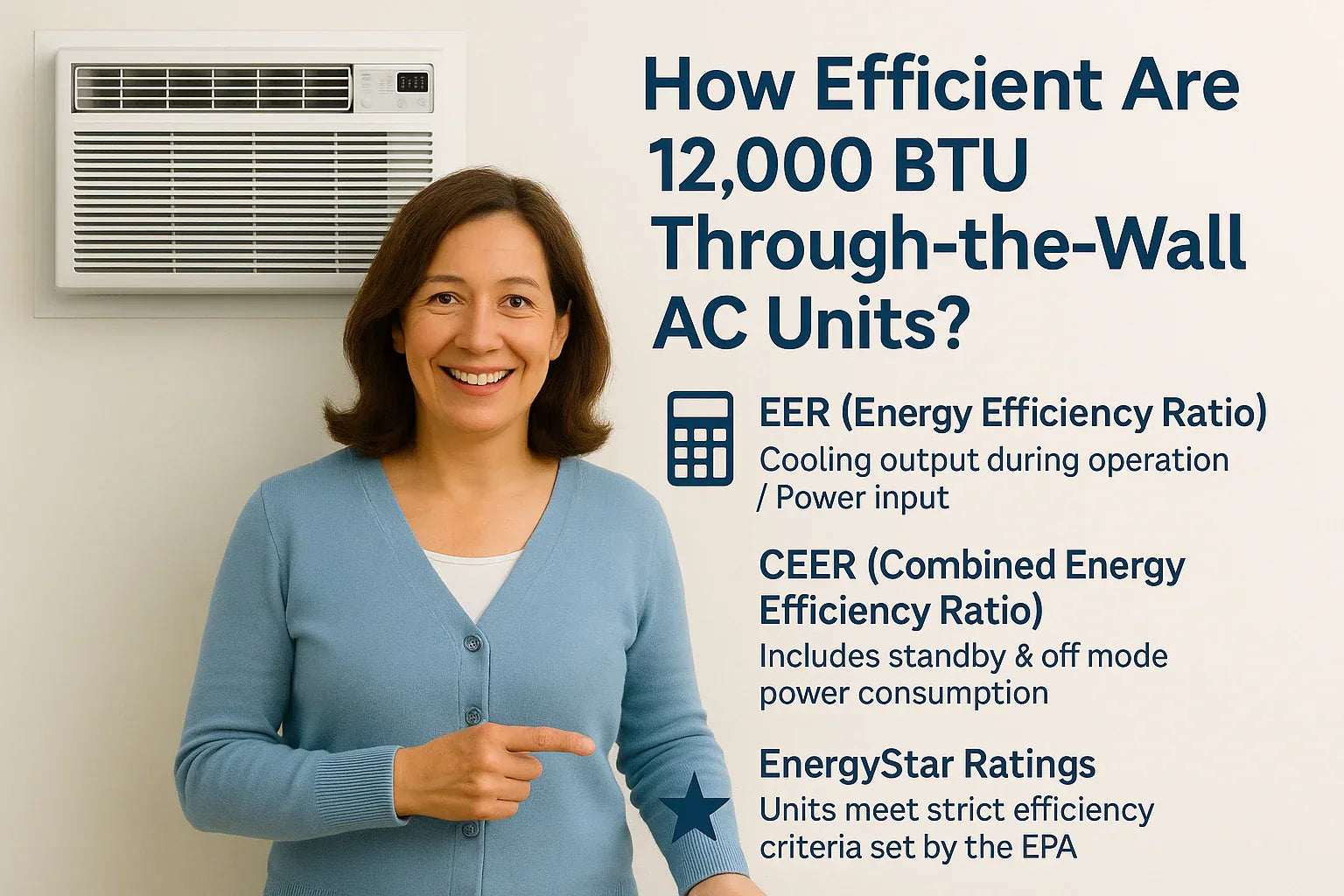1. A Summer Surprise & My Efficiency Quest
One sweltering afternoon, I noticed my energy bill spike—and I thought, “I run a 12,000 BTU through‑the‑wall AC… it shouldn’t cost this much, right?” That's what propelled me on a journey into the world of energy efficiency ratings—EER, CEER, and EnergyStar. By the end, I wanted to know: How can I keep my home cool and keep my electricity bill sane?
Best 12,000 BTU Through The Wall AC
2. What Is EER—and Why It Really Matters
EER stands for Energy Efficiency Ratio, and it's as straightforward as it sounds:
Source: Known industry definition of EER for room air conditioners (12,000 BTU range)
The U.S. Department of Energy confirms EER is the go‑to steady‑state efficiency metric for room ACs
Example:
-
Suppose my wall AC pushes out 12,000 BTU and uses 1,200 W, then:
Industry averages for through‑the‑wall units range 9.0 to 11.5
Why Samantha Cares:
EER tells me how much cooling power I'm getting for every watt I pay for—so I can compare models directly and choose smarter. Higher EER = lower energy cost.
3. Enter CEER: A Better, Real-World Metric
CEER stands for Combined Energy Efficiency Ratio—it builds on EER by adding in standby and sleep power draw:
-
It reflects energy use when the unit is "off" or idle, which matters if it's always plugged in.
-
CEER = (Cooling output) ÷ (operating watts + standby/off watts).
CEER readouts often fall between 8 and 15.
Why It’s More Realistic:
My unit runs on and off throughout the day—and sometimes turns off but stays plugged in. CEER gives a fuller picture of true daily energy usage.
4. ENERGY STAR® Certification—The Efficiency Gold Standard
EnergyStar certification is more than a label—it’s a guarantee of efficiency:
-
For room AC models (like 12,000 BTU through‑the‑wall), CEER must meet minimum thresholds, often around 10.5 or higher
-
ENERGY STAR units typically feature:
-
High-efficiency compressors and fan motors
-
Better heat transfer surfaces
-
“Energy Saver” smart modes, filter reminders—not just efficient, but smarter
-
-
ENERGY STAR cert needs lab testing and approval via EPA-recognized bodies
The ENERGY STAR product finder highlights models with better sealing, variable-speed tech, and efficient refrigerants—plus rebates!
5. Reading Real Specifications: A Model Example
I came across the GE AJCQ12DWJ, a through‑the‑wall AC with:
-
12,000 BTU cooling capacity
-
EER: 10.5, CEER: 10.5
-
ENERGY STAR certified
-
Extra features like Wi‑Fi control and efficient design
Other real models show EER ~10.6 on Energy‑Star 12k units Lowe's. These numbers reinforce what to look for.
6. Why Efficiency Prices Off with Real-Life Factors
Installation Matters
Even a tiny gap in the sleeve can leak big—ENERGY STAR warns unsealed installs waste energy
Size & Load Matching
Oversized units short cycle, cool too quickly, and don’t remove humidity well. Undersized ones run constantly. ENERGY STAR emphasizes proper sizing
Maintenance
Dirty filters cut efficiency significantly—cleaning reduces strain and boosts output.
Climate & Sun
In hot, sunny spaces, the AC works harder. Seasonally adjusted performance (like SEER) can reflect that—but EER and CEER still give round‑the‑clock insight
Understanding CEER Rating | Everything You Need To Know
7. Efficiency in Practice: Damon’s Example Calculation
Imagine replacing an old CEER 9.0 unit with a new CEER 11.0 ENERGY STAR model:
| Metric | Old AC (CEER 9) | New AC (CEER 11) |
|---|---|---|
| Daily runtime (8 h) | 12,000 BTU × 8 h = 96,000 BTU | |
| Energy use rate | 12,000 / 9 = ~1,333 W | |
| Energy used (kWh) | ~1.33 kW × 8 h = 10.7 kWh | |
| Monthly (30 days) | 10.7 × 30 ≈ 321 kWh | |
| Annual (cooling season) | ~3 months × 321 ≈ 963 kWh | |
| Cost at ₹ 10/kWh (approx.) | ₹9,630 (~US$120) |
Switching to CEER 11:
-
12,000 / 11 ≈ 1,090 W → 8 h = 8.7 kWh/day
-
Monthly ≈ 260 kWh → ₹2,600
-
Savings: ₹320 monthly (~11% less), ₹960 over the season.
I’d literally see the impact on my bill—and that’s why the efficiency ratings matter.
8. Tips to Choose the Most Efficient 12,000 BTU Through-the-Wall AC
1. Look at EnergyGuide label:
-
Shows EER, CEER, and estimated annual kWh.
2. Target Specs:
-
EER ≥ 10, ideally ≥ 12 for top efficiency
-
CEER ≥ 10.5, especially for EnergyStar units.
3. Prefer ENERGY STAR certified:
-
Guarantees lab-tested, smarter tech, and long-term savings.
4. Inverter/Variable-Speed?
-
More efficient part-load performance—some save up to 40%
5. Prioritize good installation:
-
Seal sleeves, use filter reminders, and set “Energy Saver” modes on.
9. Why These Ratings Truly Matter to You
-
Save Money—EnergyStar units use less energy.
-
Lower Environmental Impact—especially with better refrigerants
-
Comfort & Control—efficient units maintain stable temperature and humidity.
-
Smart Features—many efficient units now have Wi‑Fi, sleep modes, and reminders.
10. Samantha’s Final Summary
When you're eyeing a 12,000 BTU through‑the‑wall AC, remember:
-
EER ≈ 10+ gives better power-to-cooling ratios.
-
CEER reflects real-world energy—higher is better.
-
EnergyStar models are vetted for efficiency standards.
-
Good install and maintenance are as crucial as the numbers.
-
Over time, the savings and comfort make the difference feel real—not just on the sticker.
Wrap Up
Armed with EER, CEER, and EnergyStar info, plus a dose of Samantha-style practicality, you're in the driver's seat. Efficiency isn’t just about electronics—it’s about saving money, energy, and getting more comfort with less fuss.
In the next topic we will read about: Through-the-Wall vs. Window AC: Why Samantha Chose a Wall Unit for Her Living Room







